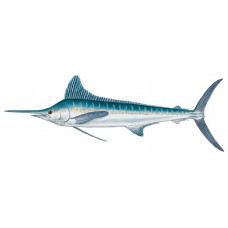Latin name
Tetrapturus albidus
Other names
Spikefish, Atlantic white marlin; French: espadon; Italian: marlin bianco; Japanese: nishimaka; nishimakajiki; Portuguese: agulhão branco, espadim branco; Spanish: aguja blanca, aguja de costa, blanca, cabezona, marlin blanco, picudo blanco.
Identification
The body is powerful, elongated, strongly flattened from the sides. Snout in form of elongated, rostrum, circular in cross-section rostrum, which length (from apex to eye) is about 18% of body length. The upper profile of the head is with rather sharp rise at the occipital part. Gill flaps are knit together. The gill arches do not have gill rakers. Dorsal fins two, are located close to each other: the first with a slightly longer base than the second, with a high, rounded front blade, its rays are sharply reduced in height, starting from about 12, the rest decrease smoothly and gradually. The second dorsal fin has a short base, shifted closer to the caudal peduncle. Anal fins are two, the second anal fin is equal in length and height to the second dorsal fin and shifted slightly forward relative to the latter. The distance between the anal opening and the beginning of the first anal fin is almost equal to the height of this fin. The pectoral fins are long and wide, with rounded apexes away from the sides of the body. The pelvic fins are thin, almost as long as or slightly shorter than the pectoral fins. The caudal peduncle is strongly flattened at the sides, and has well-developed paired carinae. The anal opening is located from the beginning of the base of the first anal fin at a distance greater than the height of this fin. The lateral line is clearly visible, with a curve above the pectoral fin. The body is covered with elongated, pointed, thick bony scales with 1-2 apexes at the ends. The body is usually lighter and tends to have a greener hue than other marlins, sometimes appearing almost chocolate brown along the back. The sides are silvery and taper to the white underbelly. There may be several light blue or lavender vertical stripes on the sides. The most distinctive feature is the rounded rather than pointed tips of the pectoral fins, first dorsal fin, and first anal fin. The first dorsal fin is convex, and the flat, mobile pectoral fins easily fold flush to the sides of the body.
Distribution
White marlin is found throughout the Atlantic Ocean from 45°N to 45°S in the west, including the Gulf of Mexico and the Caribbean Sea, and from 45°N to 35°S in the east. In North America, it is widespread in marine waters off the coast of Maryland, North Carolina, and Florida. It enters the southwestern part of the Mediterranean Sea at the coast of southern Italy.
Habitat
Marine pelagic fish, lives mainly in open waters, in the upper layers of pelagic above the thermocline and is rarely found deeper than 100 m from the surface. Prefers areas with water temperatures above 22 °C and salinity of 35-37%. As a rule, adults do not form flocks; more often they meet as single specimens or in pairs.
Size
Fish up to 8 feet long are common throughout their range. Masses of more than 82 kg. White marlin can reach a length of 10 feet. The record fish weighing 181 pounds 12 ounces was caught in Brazil in 1979.
Life history and Behavior
Although this pelagic and migratory species usually prefers deep blue tropical and warm temperate (over 81 °F) waters, it often comes ashore where depths are less than 8 fathoms. It is typically found above the thermocline, its habitat depending on the season. It is present in the higher latitudes of both the Northern and Southern Hemispheres during the respective warm seasons. Furthermore, it is normally solitary, but sometimes travels in small groups, the latter trend reflecting feeding opportunities. Spawning occurs in spring. They become sexually mature at about 130 cm in length and 14-17 kg in weight.
Food and feeding habits
White marlin feeds on a variety of pelagic fish, including sardine and herring. Squid play the most significant role in the diet.
Reproduction
Breeding peculiarities of the Atlantic white marlin, in particular, spawning seasons and habitat, are poorly studied. Presumably, individuals migrate for spawning to subtropical waters, the peak of the spawning season apparently occurs in early summer, when the temperature of surface water layers reaches 20-29 °C and salinity reaches 35%.
| Classification | |
| Phylum | Chordata |
| Class | Actinopterygii |
| Squad | Istiophoriformes |
| Family | Istiophoridae |
| Genus | Tetrapturus |
| Species | T. albidus |
| Features | |
| Conservation status | Least Concern |
| Habitat | Pelagic |
| Life span, years | No information |
| Maximum body weight, kg | 82.5 |
| Maximum length, cm | 300 |
| Sailing speed, m/s | No information |
| Threat to people | Edible |
| Way of eating | Predator |




